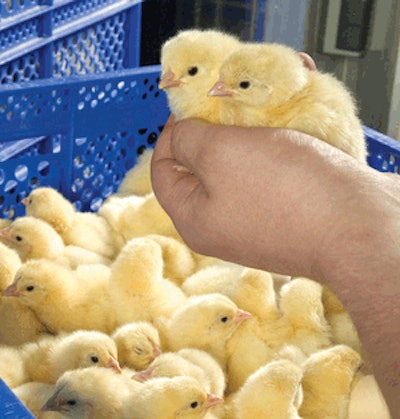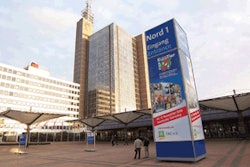
Fuelled by the healthy image poultry meat has won for itself in these body-conscious times as well as growing concern for environment and climate, broiler and turkey consumption in Europe stands between 22 and 23kg per capita for the 27-member countries. But this is only part of the picture. Take a poultry meat producer and processor like Germany's market leader Wiesenhof, and you will notice continual increases in sales of broiler, turkey and even the relative mass-market newcomer in northern Europe, duck.
With an estimated 210 million birds processed, sales of poultry meat and its products from Wiesenhof (part of the PHW Group) rose 17.4 percent to 898.9 million for the last financial year with 18.4 percent of this earned by exports, which were up 36.8 percent.
In the previous year the avian flu kicked a kink of minus 2.6 percent in the upward trend, but the overall picture for Wiesenhof is an upbeat one with turnover soaring 8 percent over last year in the first quarter this year.
So what is the secret of this singular success? Peter Wesjohann, PHW Group CEO, reckons this lies in his company's "single-source" policy.
"Consumers are increasingly concerned with assured quality, traceability but also animal welfare as well as environment and climate, and poultry meat already has a great lobby. I like to think we've added to these advantages by pioneering a lasting concept of integration and quality control which covers bird welfare, too."
This assured quality network involves Wiesenhof-owned and managed parent breeding flocks and hatcheries, but also feed mills five of them situated in main production areas and run by Wiesenhof subsidiary MEGA Tierernahrung and producing 1.1 million tonnes of ISO, QS and GMP+ certified rations annually.
This goes to the company parent flocks and some 800 contracted broiler, duckling and turkey rearers and feeders throughout Germany with one feed mill supplying the Polish integrated operation.
The company's high quality concept also includes six processing plants for about 210 million birds annually, including one (Holte, Lower Saxony) with halal certification and where a 3 million expansion is taking place this year.
Europe's most modern hatchery
What is new is the 22 million hatchery facility for producing 150 million chickens per year at Rechterfeld in Weser-Ems region. It is being hailed as the most modern in Europe with 10,000 square metres of the 18,000m2 complex completely new. The Weser-Ems hatchery features 64 setter and 96 separate hatcher departments: the eggs straight from the parent flocks are all disinfected before placing in the setter areas. One of seven hatcheries run by Wiesenhof, the new facility features a complete separation of eggs and chicken with separate entrances and staff. Traceability starts in the parent flock with Wiesenhof. Every Wiesenhof chicken produced comes into the world with a hatchery batch number that accompanies it right through rearing to the processing plant and retail outlet. Other tracebacks include a "salmonella watch" with weekly samples taken from birds and manure in parent flocks. Independent organisations and the company's own veterinary inspectors carry out regular tests among the selected feeding farms. Managers have a strict hygiene and welfare regime to follow covering feed and water availability, stocking rates, ventilation, heating and lighting with full documentation required at every stage.
The contracted farmers rearing and feeding Wiesenhof poultry also have strict product quality and welfare guidelines. On-floor housing with natural straw litter is mandatory. Broilers, for example, have a stocking density maximum of 35kg live weight per square metre. Depending on their age, this means between 18 and 23 birds per square metre.
Bio-chickens and turkeys
With 20 percent of German households preferring "natural production" methods for their food (ACNielsen Trend Navigator Bio 2007), it is not surprising that Wiesenhof has put some priority into the integrated production of organic poultry meat.
Already in 2002, the company was enjoying first success with its organic poultry products and by 2004 had changed its "free range" broiler lines so that they could be registered as organic, too, under the EC Organic Agriculture Regulation and under the Bio Quality label issued by the German Ministry of Agriculture and Consumer Protection.
In the past two years, introductions have widened the range of these value-added meats with products such as broiler breast fillets, wings and drumsticks as well as bio-turkey breast and steaks. Even newer is a range of poultry meat sausage from the bio-sector including smoked turkey breast and a poultry meat version of the German speciality Jagdwurst or hunter's sausage.
Wiesenhof bio-broilers and turkeys are produced on elite contracted farms where, for example, stocking density for broilers is a maximum 10 per m2 and for turkey hens 2.1 per m2. The greened outside run must have at least 4m2 per bird (for a minimum 1/3 production) and 10m2 per turkey over the same period.
Demand for the bio-poultry from Wiesenhof has been such that in May last year the weekly slaughter total for this sector was doubled to 4,000 birds.
Expansion in the east
An investment in the Polish poultry processing sector has paid off handsomely for Wiesenhof with its two subsidiaries there, the broiler integrator Drobimex and turkey meat specialist Bomadek increasing sales by a record 52.6 percent in the 2006-07 year to June with total turnover of 102.9 million. In 2005 Drobimex spent almost 5 million on a new hatchery near Stettin (Sczeczin) with 20 setter and 10 hatcher chambers and a total output capacity of 550,000 chicks per week. As an independent processor, Drobimex already had a good reputation in Poland as an integrator in the broiler meat sector.
Wiesenhof parent company PHW Group stepped in to take a partnership with Bomadek in 2003 and has a turkey processing capacity at its Trzebiechow plant of between 6,000 and 7,000 turkeys daily.
Peter Wesjohann said, "We have created a closed integration of our poultry production in Poland and we will be servicing the eastern European market from there."
Turkey and duck investment
Certainly, investment in the processing side is not slowing down. A new turkey facility is being built this year by daughter company Geestland Putenspezialitäten in the Oldenburg region of Lower Saxony. Capacity: from 3,000 turkeys per day.
Geestland also has a turkey hatchery in the region. This year, Wiesenhof claims 25 percent of turkey meat sold in Germany comes from its hatcheries, contract growers and processing plants (the figures for Wiesenhof broilers and ducks are 40 and 70 percent respectively).
Duck production and processing has so far concentrated on the German market, and this has boomed with last year's total duck meat sales from all processors increasing almost 10 percent over the previous year to a record 53,000 tonnes. The main reason for this, says Peter Wesjohann, is that duck is losing its seasonal character and becoming accepted as an all-year-round dish at home and in restaurants.
"We want to participate in this development and Wiesenhof has invested massively in production from eastern Germany. At the same time, we are developing rapidly in Hungary where we aim to export duck meat, mainly for the other European markets."
The Wiesenhof decision to invest in further duck development created the daughter concern, Wiesenhof Entenspezialitäten (duck specialities), now including two processing plants in eastern Germany and a dedicated duck hatchery, in which the company invested 29 million in 2005 a year when the duck branch recorded a turnover of 29 million. With a very large share of the home market, the Wiesenhof duck meat sector has not forgotten the export market with main targets reported to be Scandinavia, Eastern Europe, Great Britain and Ireland for a range of cuts and convenience dishes.
"In Germany, too, we see great popularity developing for poultry specialities, finger food and snacks, above all with younger consumers and families," Peter Wesjohann said. "In demand are products for quick and simple production at home but always at an attractive price. The convenience trend for all our bird types will therefore continue to establish itself as a major factor in our sector."
And what about poultry consumption in general? "Europe is still way behind the per capita consumption in the USA," he admits. "But the social development here and I am thinking especially of the healthy-eating trends will mean we will be moving nearer fairly rapidly in the near future."

















